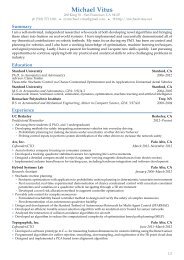Tunnel-MILP: Path Planning with Sequential Convex ... - Michael Vitus
Tunnel-MILP: Path Planning with Sequential Convex ... - Michael Vitus
Tunnel-MILP: Path Planning with Sequential Convex ... - Michael Vitus
Create successful ePaper yourself
Turn your PDF publications into a flip-book with our unique Google optimized e-Paper software.
<strong>MILP</strong> does not scale very well <strong>with</strong> the number of obstacles in the environment. Since each obstacle edgerequires a set of binary variables for every timestep under consideration, the number of binary variablesscales linearly in the number of obstacle edges. It is well known that <strong>MILP</strong> is NP-hard in the number ofbinary variables used in the problem formulation, 7, 8 and so computational requirements grow exponentiallyas the number of binary variables needed to model the problem increases. The result is an algorithm that canmanage at most a limited number of obstacles in a reasonable time for applications such as those envisagedfor STARMAC.Instead, this work proposes to break down the task of determining a dynamically feasible trajectorythrough an obstacled environment into a three step algorithm. First, a desirable path is determined <strong>with</strong>outany consideration of vehicle dynamics. This can be done <strong>with</strong> either a visibility graph approach to findingthe shortest path, 9, 10 11, 12or by gradient descent of a fast-marching potential. Next, a tunnel is formedthrough the environment as a sequence of convex polytopes through which the vehicle must travel. Finally,a dynamically feasible trajectory is generated using a <strong>MILP</strong> formulation that restricts the vehicle’s path tostay <strong>with</strong>in the pre-defined tunnel.The <strong>Tunnel</strong>-<strong>MILP</strong> method relies on the following insight: requiring the state to remain inside a convexpolytope requires no binary variables, whereas requiring the state to remain outside a convex polytoperequires one for each edge. By first determining a path ignoring the vehicle’s dynamics, then identifyingthe sequence of convex regions through which to travel, the resulting <strong>MILP</strong> needs only determine at whichtimestep to make the transition from one polytope to the next. Care in formulating the <strong>MILP</strong> has provenuseful in other aerospace applications as well. 13, 14 In all these cases, the result is a problem formulation <strong>with</strong>fewer binary decision variables, and therefore, <strong>with</strong> the potential for slower growth in computation time.Other attempts have been made to address the issue of problem size in <strong>MILP</strong> formulations of the obstacleavoidance problem. Bellingham, Richards, and How 15 developed a receding horizon <strong>MILP</strong> controller to planshort trajectories around nearby obstacles. Earl and D’Andrea 16 have proposed an iterative method forincluding obstacles as they are detected to interfere <strong>with</strong> the current best route. Their algorithm seeks toensure continuous time obstacle avoidance, and to find minimum time solutions through binary search <strong>with</strong>a continuous end time. As the density of obstacles and the complexity of the environment increases, thenumber of <strong>MILP</strong> instances can grow quickly, resulting in slow performance of the algorithm.For problems <strong>with</strong> a very large number of constraints, there do exist randomized methods, such a probabilisticroadmaps (PRM). 17 Computation time for PRMs scales <strong>with</strong> the expansiveness of the space, asopposed to the number of obstacles or binary constraints. This makes PRMs attractive for large problems;however, optimality is not explicitly considered in the problem formulation, often resulting in windy orsinuous paths if vehicle dynamics are incorporated.The paper proceeds as follows. Section II presents a standard <strong>MILP</strong> formulation of the path planningproblem based on work by Richards et al. 6 Then, each of the three stages of the <strong>Tunnel</strong>-<strong>MILP</strong> algorithm aredescribed in detail in Section III. In Section IV, an analysis of the computational complexity and solutionoptimality are presented. A breakdown of the computation times for the <strong>Tunnel</strong>-<strong>MILP</strong> algorithm andcomparison <strong>with</strong> previous methods are presented in Section V. Finally, Section VI includes a brief discussionof directions of future improvements.II.Problem FormulationThe environment under consideration is assumed to be a bounded convex polytope in 2-D. Let N E bethe number of edges of the polytope, F E ∈ R N E ×2 define the outward normals to each edge, and G E ∈ R N Ebe the offset. Then the environment E = {x ∈ R 2 |F E x − G E ≤ 0} ⊂ R 2 is defined to be the interior of thepolytope.Similarly, obstacles can be defined that lie inside the environment. Let N O be the number of obstacles,and for each obstacle i, let NiO be the number of edges. Each obstacle O i ∈ O can then be defined analogouslyto the environment <strong>with</strong> components Fi O ∈ R N O i ×2 and G O i ∈ R N O i .The obstacle avoidance problem is posed over a finite time horizon T max ∈ R <strong>with</strong> T timesteps of fixedlength δt ∈ R. The vehicle navigating through this environment is modeled <strong>with</strong> standard linear point massdynamics,p(t + 1) = p(t) + v(t)δt + u(t)δt 2 /2(1)v(t + 1) = v(t) + u(t)δt2 of 13American Institute of Aeronautics and Astronautics



